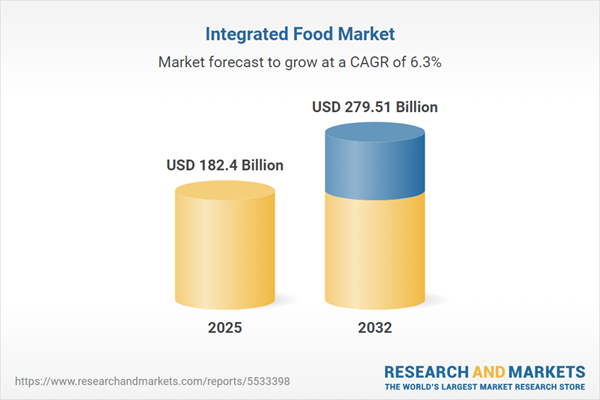Speak directly to the analyst to clarify any post sales queries you may have.
Senior decision-makers navigating the integrated food market must continuously adapt to regulatory shifts, rapid digital innovation, and evolving consumer demands. Strategic agility and informed, forward-thinking approaches are essential in sustaining a competitive edge within a market shaped by ongoing operational, compliance, and customer expectations.
Market Snapshot: Integrated Food Market Size and Dynamics
The integrated food market is experiencing steady expansion, driven by accelerated digital transformation, supply chain transparency initiatives, and a growing commitment to sustainability practices. Organizations are responding to heightened expectations for convenience, quality, and tailored product options as consumer segments diversify. Digital tools now enable greater operational agility, and market leaders are advancing their excellence under increased regulatory and public scrutiny. This fast-evolving environment demands that companies frequently evaluate their processes and value creation strategies to secure long-term market positioning.
Scope & Segmentation: Integrated Food Market Coverage
- Product Types: Categories including baked goods, beverages, dairy, meat and seafood, confectionery, prepared meals, and snacks are designed to meet nutritional requirements and accommodate global preferences for ease and personalization.
- Applications: Food service operators, institutional buyers, retail stores, e-commerce channels, and supermarkets emphasize efficient supply chains and flexible sourcing to align quickly with shifts in consumer behavior.
- Packaging Types: Options such as glass jars, pouches, flexible bags, metal cans, and advanced films enable sustainable practices, support regulatory alignment, reinforce brand reputation, and boost inventory management efficiency.
- Nature Segments: Conventional and organic products meet transparency expectations and cater to mainstream, health-conscious, and niche markets within an increasingly segmented consumer landscape.
- Geographies: The report covers the Americas, Europe, Middle East & Africa, and Asia-Pacific, with Europe leading sustainability compliance and Asia-Pacific responding to swiftly changing preferences and premiumization trends. Regional influences continue to drive advances in product development and sourcing strategies.
Key Takeaways for Senior Decision-Makers
- Broadening product portfolios and establishing resilient supply networks support diverse customer needs while aligning with evolving compliance frameworks.
- Adoption of real-time analytics and blockchain technologies enhances interpretation of market trends, driving more responsive and informed strategic moves.
- Integrating ESG principles into core activities increases operational resilience, augments stakeholder confidence, and helps organizations remain agile amidst market changes.
- Forming strategic alliances with technology partners and specialists in ingredients accelerates development and opens pathways to address dynamic consumer requirements.
- Refining distribution and product strategies ensures effective responses to varying regional standards and regulatory distinctions within a complex global landscape.
- Leveraging omnichannel and direct-to-consumer sales models improves access to real-time insights and sharpens the supply chain’s ability to deliver value.
Tariff Impact: Navigating Supply Chain Adaptation
Current U.S. trade policies have contributed to increased unpredictability in sourcing specialty dairy, protein ingredients, and packaging materials. In response, companies are actively broadening supplier bases, intensifying localized production, and amending contractual terms to mitigate risk. Robust digital trade management systems support scenario planning, safeguarding logistics against continued regulatory and policy fluctuations.
Methodology & Data Sources
The report synthesizes insights collected from senior executive interviews, sector experts, and logistics professionals. All data points receive rigorous validation using authoritative documentation, supporting strategic decision-making for leadership and planning teams.
Why This Report Matters for Strategic Planning
- Enables strategic alignment as compliance standards and buyer needs develop in a shifting regulatory environment.
- Provides tactical guidance for embedding digital technologies and sustainable methods across organizational operations to maintain growth during market disruptions.
- Supports targeted investment decisions in innovation and packaging, allowing organizations to prioritize adaptation and operational excellence.
Conclusion
Effective engagement in the integrated food market depends on advancing digital capabilities, embedding ESG standards into daily operations, and remaining attentive to fast-evolving market signals. Senior leaders who drive flexibility and partnership are best positioned to achieve long-term success.
Additional Product Information:
- Purchase of this report includes 1 year online access with quarterly updates.
- This report can be updated on request. Please contact our Customer Experience team using the Ask a Question widget on our website.
Table of Contents
3. Executive Summary
4. Market Overview
7. Cumulative Impact of Artificial Intelligence 2025
Companies Mentioned
The companies profiled in this Integrated Food market report include:- Compass Group PLC
- Sodexo SA
- ISS A/S
- Aramark Corporation
- Elior Group SA
- Gategroup Holding AG
- Delaware North Companies, Inc.
- Autogrill S.p.A.
- SSP Group PLC
- ABM Industries, Inc.
Table Information
| Report Attribute | Details |
|---|---|
| No. of Pages | 197 |
| Published | November 2025 |
| Forecast Period | 2025 - 2032 |
| Estimated Market Value ( USD | $ 182.4 Billion |
| Forecasted Market Value ( USD | $ 279.51 Billion |
| Compound Annual Growth Rate | 6.2% |
| Regions Covered | Global |
| No. of Companies Mentioned | 11 |









